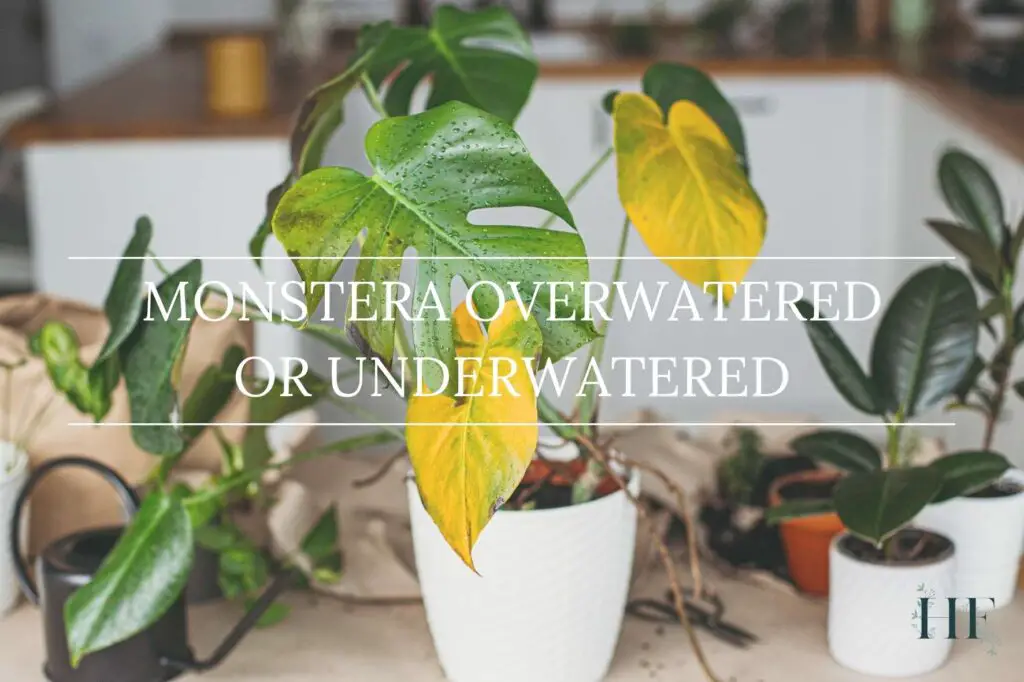While it’s great to know when your Monstera needs water, it’s also good to know about overwatering and underwatering your Monstera.
Dry soil is the clearest sign of a Monstera being underwatered, while wet or waterlogged soil is an indicator that your Monstera is overwatered.
Yellow leaves can also indicate that your Monstera is underwatered, especially if it’s accompanied by dry (crispy) brown spots or curling leaves. However, if you see soft dark brown spots on yellowing leaves, your Monstera is most likely overwatered.
Let’s look at all the signs and what you can do to fix the problem!
Monstera Overwatering vs Underwatering
Although you understand what these terms mean, it can be confusing to actually distinguish between the two when it comes to watering your plants.
So, what’s the difference?
The best thing to do is to go through the process of elimination.
If your Monstera hasn’t experienced any changes in its environment (no changes in light, humidity, location) and hasn’t been repotted in a while, it’s time to check the moisture in the soil.
One of the most accurate methods to do that is to use a moisture meter. Simply insert the sensor into the soil halfway between the base of the plant and the edge of the pot, and about halfway down into the pot. I recommend this moisture meter (it’s what I use).
The meter will let you know if the soil is dry (1-3), moist (4-7) or wet (8-10).
If you don’t have one, you can stick your finger into the soil until you are about 1 inch (2.5 cm) or two knuckles deep and gauge the moisture level of the soil.
But, keep in mind that the soil may feel dry a few inches down even when the root ball is soaked. That’s why a moisture meter can be more helpful.
- If the soil is wet, your Monstera is overwatered. If your soil feels wet less than 2 inches below the surface or reads wet (8-10) on your meter and you haven’t watered for a few days, your Monstera is waterlogged.
- If the soil is dry, your Monstera is underwatered. If the soil feels very dry more than a few inches down or reads dry (1-2) on your moisture meter, your Monstera plant needs water.
Here are other ways to distinguish between an overwatered and underwatered Monstera.
| OVERWATERED MONSTERA | UNDERWATERED MONSTERA |
|---|---|
| Constant wet soil. | Dry soil. |
| Lower leaves turn yellow and brown. | Leaves drop and curl before turning brown. |
| A foul smell coming from the soil. | No smell coming from the soil. |
| Roots become mushy and black or brown. | Roots feel papery and thin. |
Continue reading to find out more about Monstera overwatering and underwatering signs.
To prevent both scenarios, it’s key to follow an appropriate watering practice. Check my A Guide to Monstera Water Needs (How Often and When) for some helpful tips.
Insider Tip: Monstera plants have a moderate water requirement, which means you should water when the soil feels moist one or two inches below the surface.
As a general rule, you can water your Monstera when the topsoil has dried to about 80% of the way, which means that the soil feels moist 1 to 2 inches below the surface.
Overwatered Monstera
Overwatering is a more serious issue than underwatering, and a more frequent problem.
Although the main cause of overwatering is due to watering too often (especially during their dormant period), it may occur due to heavy, poorly drained soil, oversized pots, or lack of drainage.
Monstera plants are susceptible to soggy or waterlogged soils, which leads to root rot. When overwatered, the roots will not get enough oxygen. As a result, they cannot absorb water and nutrients well.
Moreover, these conditions favour the growth of bacteria and fungus. If this issue is not caught on time, this fungus and bacteria will attack the weakened roots causing them to root.
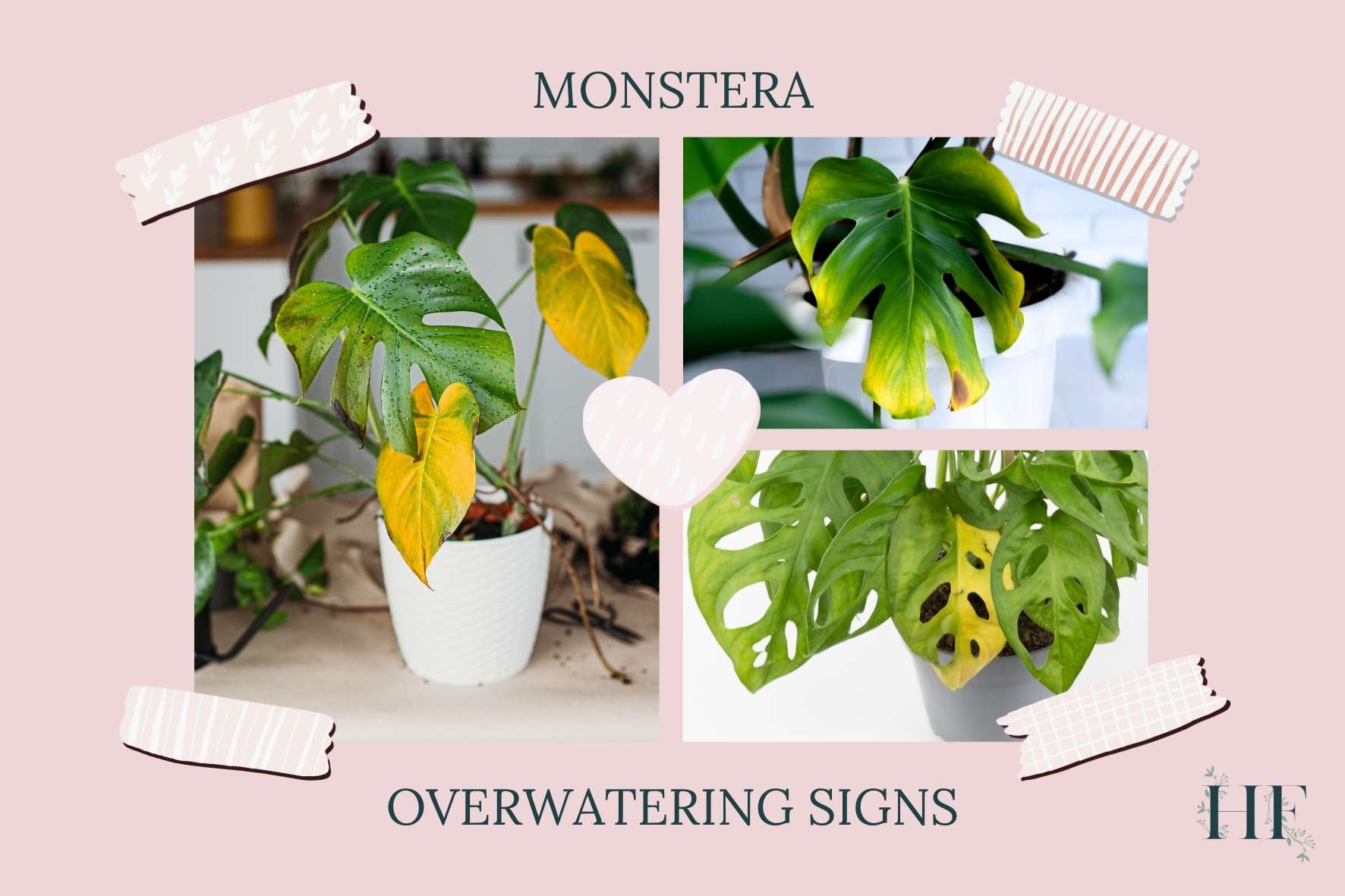
Monstera Overwatering Signs
Signs your Monstera is overwatered include:
1) Yellowing Leaves
This is one of those issues that can have many different causes (such as nutrient deficiency). But both overwatering and underwatering can cause your Monstera’s leaves to turn yellow.
When overwatered, apart from wet soil, you will notice the older leaves or the leaves toward the bottom of the plant, yellowing first.
2) Brown Spots
Like yellow leaves, brown spots can have all kinds of causes, including root rot (which is caused by overwatering) and excessive dryness (a.k.a. underwatering).
Other possible causes are fertiliser burn due to overfertilization, lack of humidity, and bacterial infection.
If you see brown spots forming on your Monstera’s leaves, the first thing you can do is check the moisture levels of the soil.
If your Monstera is overwatered, you will find soft, dark brown spots on the lower leaves. This can also indicate root rot, especially if your Monstera’s stems are also getting dark and mushy.
If that is the case, you will need to act right away so you can save your plant! Continue reading to learn how to fix overwatering issues.
3) Root Rot
Although root rot is not easy to perceive at first sight, a rotting smell coming from the soil is a good indicator that your Monstera has root rot due to overwatering.
Root rot will slowly damage the root system of your Monstera without showing symptoms at an early stage. Sometimes, by the time you perceive a rotting smell, it’s already too late to save your plant.
You can always confirm this by checking the moisture levels using a moisture meter. Wet soil reads between 8 to 10.
If you check the roots, you will probably find rotten, stinky, and gooey roots.
Read also: Monstera Root Rot Signs, Causes and Recovery Tips.
4) Mould Growing on the Soil
Soggy soil will show signs of mould growing on the soil surface. This is another clear sign that your Monstera has an overwatering problem.
You want to get rid of this mould because, apart from harming your plant, it’s toxic to humans. It can cause respiratory issues.
5) Wet or Waterlogged Soil
Finally, wet or waterlogged soil is the main sign that your Monstera plant has too much water.
Wet and soggy soil conditions are life-threatening to all Monsteras. It’s the perfect breeding ground for fungus, which is the main culprit of root rot.
You can also see signs of wilting and drooping despite wet soil.
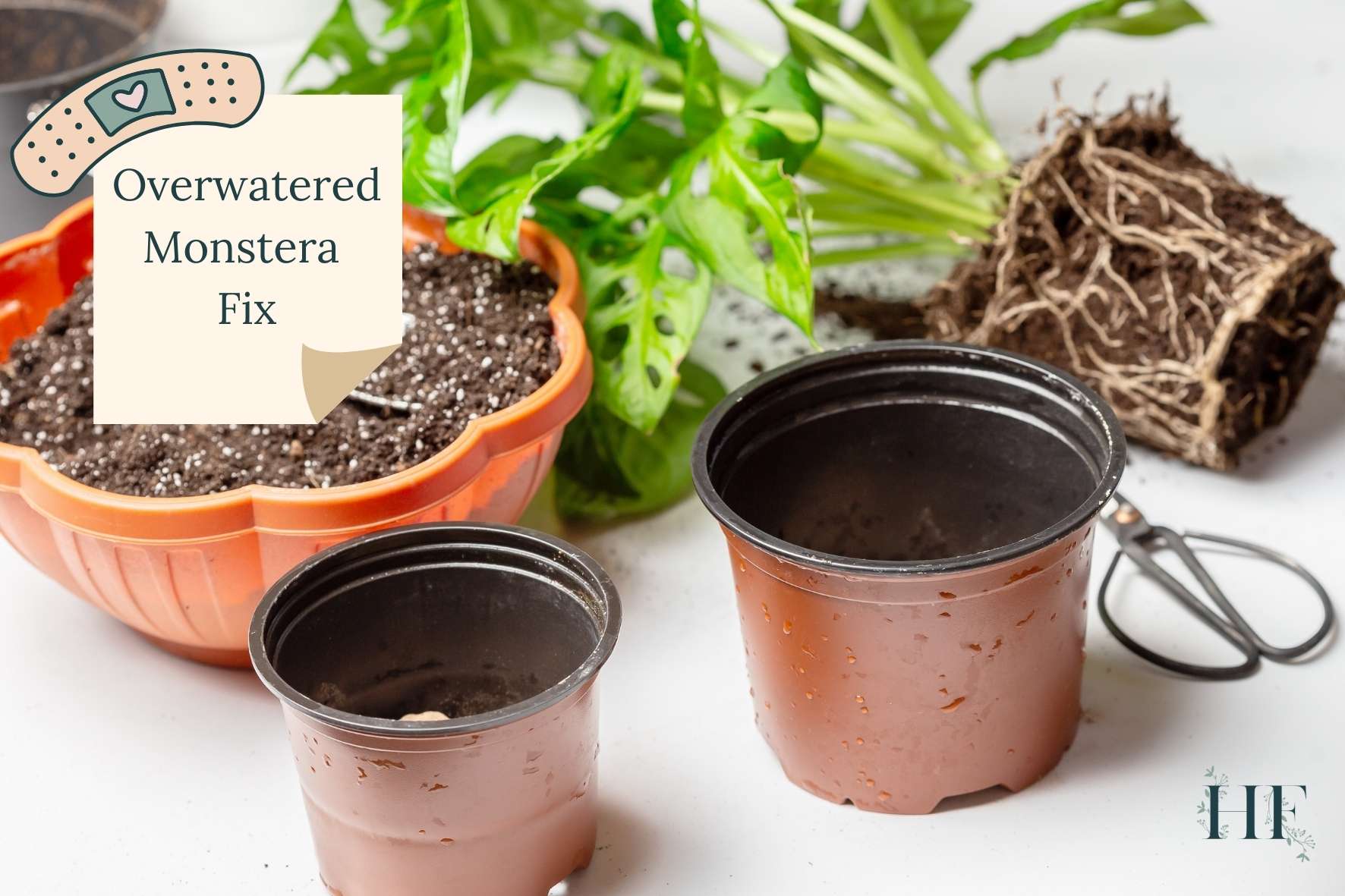
How Do You Fix Overwatered Monstera?
The first thing to do is stop watering your Monstera and check if its roots have any signs of root rot. If all of them are white or yellowish, there is no root rot yet.
If your Monstera plant is a little overwatered and not showing signs of root rot, simply give it a chance to dry out before watering it. But, if the problem continues, you may need to repot your Monstera into a new pot using a potting mix with better drainage.
Read also: Which Type of Soil Is Best for Monstera? and A Guide to Repotting Monstera (When, Why and How).
However, if your Monstera has root rot, you are more likely to save it if it is at its early stage. Check Monstera Root Rot Signs, Causes and Recovery Tips to find out how you can treat Monstera root rot depending on its stage of decay.
If you spot root rot, repot your Monstera immediately. As you repot, wash the roots under running water and try to remove as much soil as possible. Then, cut any brown, black, mushy or slimy roots using sterilized pruning scissors. I recommend using these pruning shears after being washed with soap or white vinegar.
Insider Tip: When repotting, I recommend using a clean pot (you can use a new one or clean the old one) with drainage holes to make sure that no fungus or bacteria are present.
Also, apply a fungicide solution to kill any bacteria left and prune away any yellow leaves too.
To prevent overwatering issues from happening in the future, make sure to check out my A Guide to Monstera Water Needs (How Often and When).
Underwatered Monstera
Monsteras grow in tropical rainforests, which means they need moist soil and are not drought resistant.
While it’s important to let the topsoil dry out between waterings, a Monstera Deliciosa (and other varieties) shouldn’t be living in dry soil conditions since it will negatively affect its ability to grow efficiently.
Reasons for underwatering are forgetting to water your plant or extreme conditions that will make the soil dry out quickly and the leaves lose moisture.
Insider Tip: It’s better to slightly underwater your Monstera than to overwater it. You can always add more water, but removing water is a lot harder!
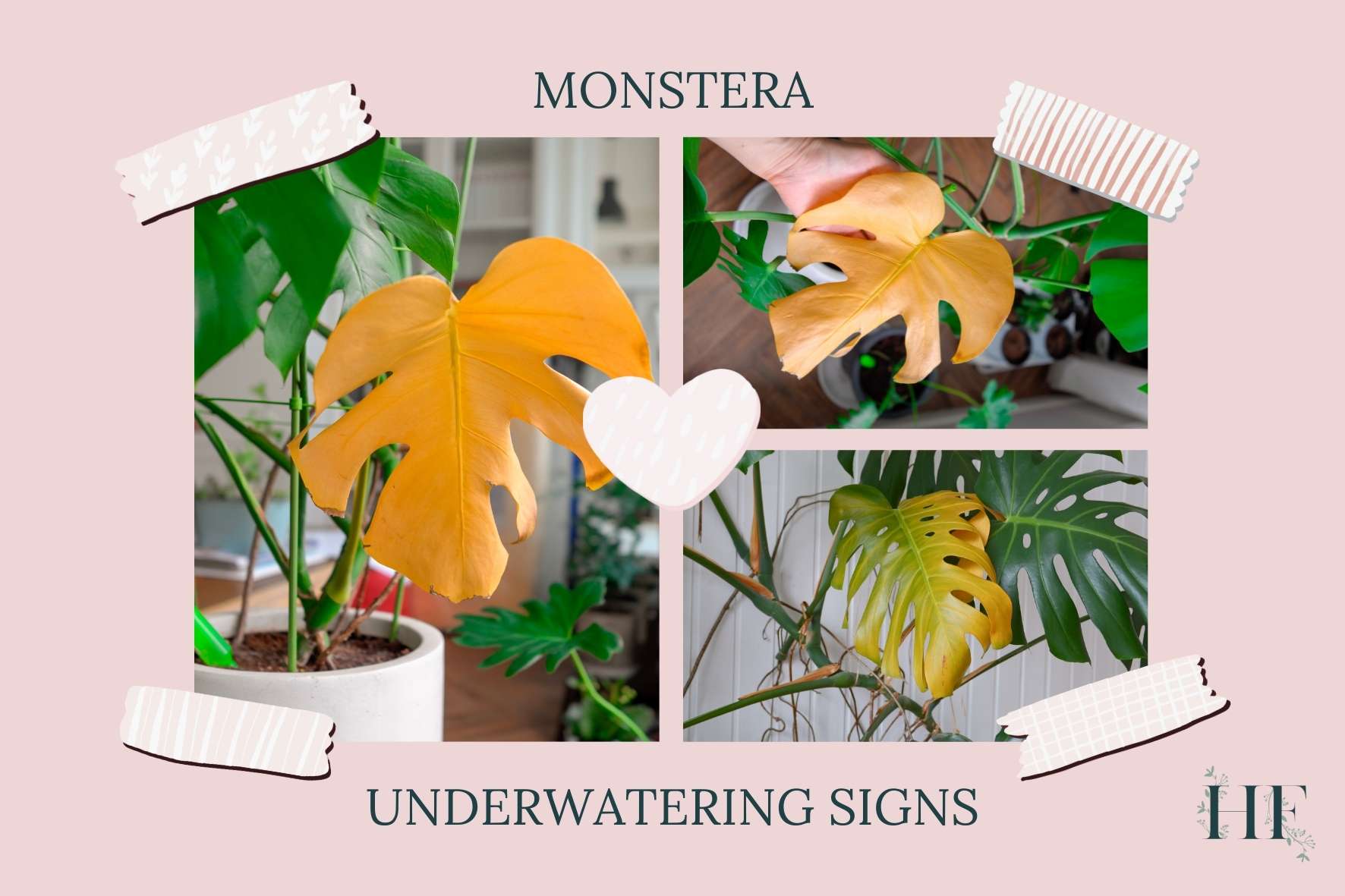
Monstera Underwatering Signs
Signs your Monstera is underwatered include:
1) Yellowing Leaves
Although yellow leaves can also indicate overwatering issues or nutrient deficiency…
When underwatered, your Monstera’s leaves will start to turn yellow, possibly starting with the newer, more vulnerable leaves.
2) Brown Spots
As mentioned before, brown spots have many causes, so check the moisture levels of the soil first.
If your Monstera is underwatered, the brown spots are crispy and they usually start from the edges of the leaves and affect leaves all over the plant.
You can also see brown leaf tips and edges, especially in older foliage. This is a sign of sunburn.
3) Drooping, Sagging, Wilting or Leaning
A leaning Monstera is a sign of water deficiency. Also, your Monstera leaves could be drooping or wilting (similar to wilting in a Peace Lily, Spathiphyllum, when it’s thirsty).
An underwatered Monstera will start to sag, as a result, and its stems and leaves will droop. This might be easier to observe on a young Monstera but it would also be obvious on larger plants.
If the cause of drooping is too little water, your Monstera should perk back up in a day or two.
However, your Monstera could drop if it’s experiencing root shock from being moved recently. So, if you have repotted your Monstera recently or changed its location, this is probably the cause.
It can also be due to not getting enough light or if it’s too cold.
So, if your Monstera’s living conditions haven’t changed in a while, check the soil to confirm if it’s an underwatering problem.
4) Slow Growth or No New Growth
If your Monstera doesn’t seem to be growing, it can be due to low light conditions, lack of nutrients or because it’s thirsty.
If the light conditions haven’t changed or it’s getting enough light and you have recently fertilised your plant, it’s time to check the soil.
Remember that Monsteras go through a dormant period from autumn and winter, so slow growth or no growth at all is expected during those months.
Lack of fenestration is an indicator that a Monstera is not getting enough of something (unless it is a young plant).
Since lack of water is not the only reason, check the soil moisture first before watering and also rule out that it’s not happening due to too little sunlight.
5) Curling Leaves
Wrinkled, crispy leaves, is a sign of dehydration. So, if your Monstera has an underwatering problem, its leaves will begin to curl inwards (looking smaller and not as wide).
After being watered, leaves will return to their natural state in a few days.
Curling leaves can also be a sign of low humidity, so ensure that your Monstera plant isn’t sitting near a heating or AC vent in addition to checking the soil.
If the soil seems to be retaining moisture just fine, you may want to set up a humidifier since Your Monstera may need higher humidity levels.
But if the soil is compacted or just dry, underwatering may be the cause.
6) Dry Soil
Finally, dry soil is the main sign that a Monstera plant needs watering. Also, I find it the easiest to recognize.
You can monitor or measure the moisture in the soil using the finger test, the stick method or using a moisture meter (which is the most accurate method, especially if you are unsure).
Insider Tip: The clearest sign that a Monstera needs water is dry soil. So, regardless of the other signs you spot, always check the soil before watering.
Also, try to avoid letting Monstera plants get too dry as it will stress the plant and negatively affect its growth.
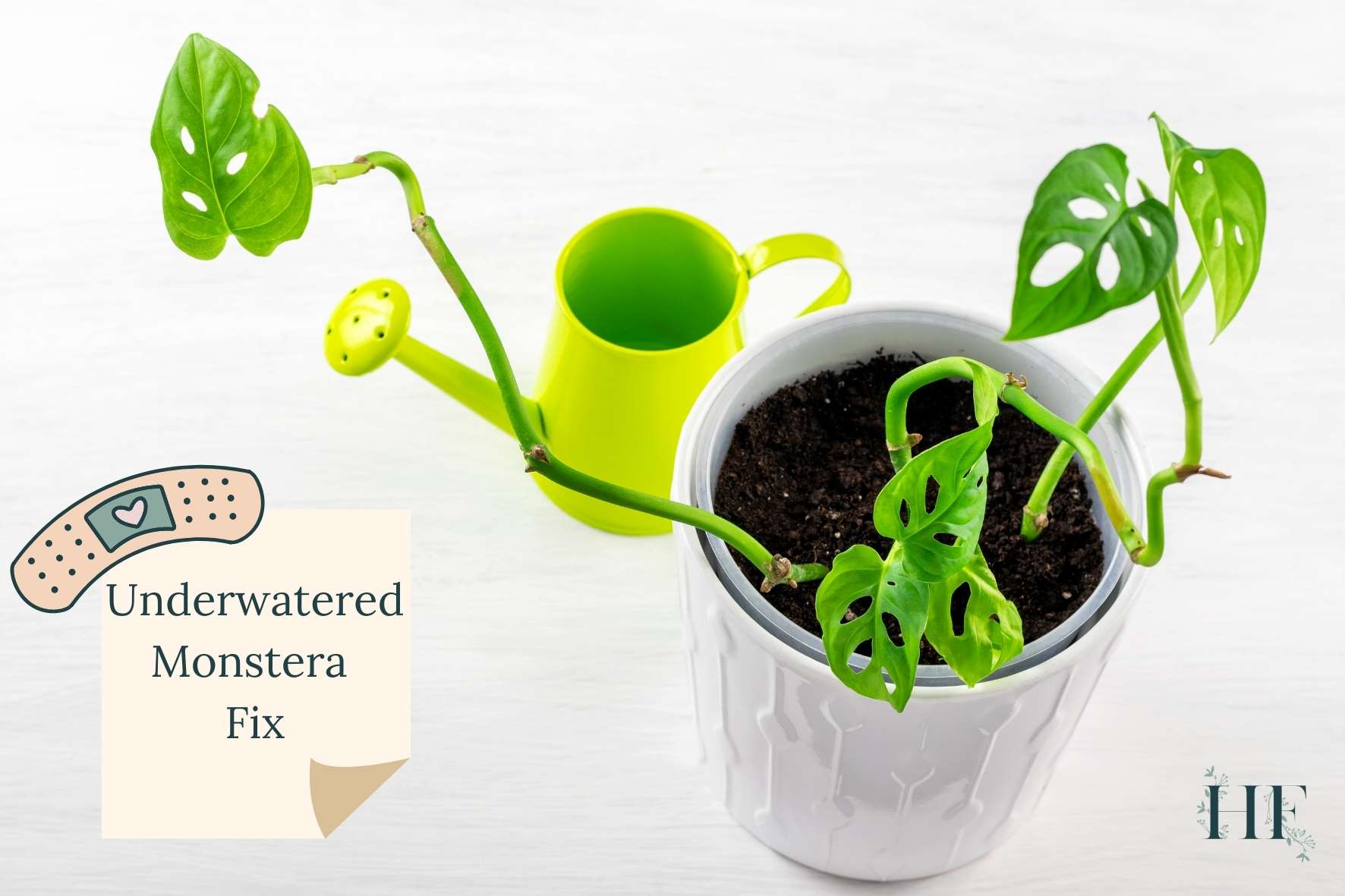
What to Do If Monstera Is Underwatered
If your monstera is just a little thirsty but overall okay, you can just give it a good watering and your plant will recover.
If your Monstera is severely dried out and there are damaged leaves (any brown or yellow leaves), you can trim them off and water your plant thoroughly.
Read also: A Guide to Monstera Water Needs (How Often and When) and
A Guide to Monstera Pruning (How, When and Why).
To avoid underwatering issues, do your best to monitor your Monstera and stay on track with its watering schedule. You can pick a day of the week to check your plant, then either set up a reminder alert or add an event to your calendar. This can ensure you don’t forget to water your Monstera!
Insider Tip: Always check the soil first before watering!
If the underwatering problem persists, you might want to consider repotting your Monstera so you can modify its potting mix, making it more suitable for your watering habits and your Monstera’s habitat.
Lighter potting soil mixes will drain quicker and your Monstera plant might need more frequent watering as a result.
Read also: Which Type of Soil Is Best for Monstera? and A Guide to Repotting Monstera (When, Why and How).

